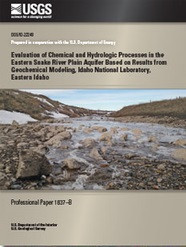
Product Details
- Product Number
- 368464
- Series
- SIR-2012-5219
- Scale
- 1:100,000
- Alternate ID
- SIR-2012-5219
- ISBN
- 978-1-4113-3512-7
- Authors
- CHRISTOPHER L BRAUN
- Version Date
- 01/01/2012
- Regions
- WA, ID
- Countries
- USA
- Media
- Paper
- Format
- Bound
Additional Details
- Description
-
Abstract
Lower Granite Dam impounds the Snake and Clearwater Rivers in eastern Washington and northern Idaho, forming Lower Granite Reservoir. Since 1975, the U.S. Army Corps of Engineers has dredged sediment from the Lower Granite Reservoir and the Snake and Clearwater Rivers in eastern Washington and northern Idaho to keep navigation channels clear and to maintain the flow capacity. In recent years, other Federal agencies, Native American governments, and special interest groups have questioned the negative effects that dredging might have on threatened or endangered species. To help address these concerns, the U.S. Geological Survey, in cooperation with the U.S. Army Corps of Engineers, collected and analyzed bed-sediment core samples (hereinafter cores) in Lower Granite Reservoir and impounded or backwater affected parts of the Snake and Clearwater Rivers. Cores were collected during the spring and fall of 2010 from submerged sampling locations in the Lower Granite Reservoir, and Snake and Clearwater Rivers. A total of 69 cores were collected by using one or more of the following corers: piston, gravity, vibrating, or box. From these 69 cores, 185 subsamples were removed and submitted for grain size analyses, 50 of which were surficial-sediment subsamples. Fifty subsamples were also submitted for major and trace elemental analyses. Surficial-sediment subsamples from cores collected from sites at the lower end of the reservoir near the dam, where stream velocities are lower, generally had the largest percentages of silt and clay (more than 80 percent). Conversely, all of the surficial-sediment subsamples collected from sites in the Snake River had less than 20 percent silt and clay. Most of the surficial-sediment subsamples collected from sites in the Clearwater River contained less than 40 percent silt and clay. Surficial-sediment subsamples collected near midchannel at the confluence generally had more silt and clay than most surficial-sediment subsamples collected from sites on the Snake and Clearwater Rivers or even sites further downstream in Lower Granite Reservoir. Two cores collected at the confluence and all three cores collected on the Clearwater River immediately upstream from the confluence were extracted from a thick sediment deposit as shown by the cross section generated from the bathymetric surveys. The thick sediment deposits at the confluence and on the Clearwater River may be associated with floods in 1996 and 1997 on the Clearwater River.
Fifty subsamples from 15 cores were analyzed for major and trace elements. Concentrations of trace elements were low, with respect to sediment quality guidelines, in most cores. Typically, major and trace element concentrations were lower in the subsamples collected from the Snake River compared to those collected from the Clearwater River, the confluence of the Snake and Clearwater Rivers, and Lower Granite Reservoir. Generally, lower concentrations of major and trace elements were associated with coarser sediments (larger than 0.0625 millimeter) and higher concentrations of major and trace elements were associated with finer sediments (smaller than 0.0625 millimeter).
- Height In Inches
- 11.000
- Length In Inches
- 8.500
- Two Sided
- Yes
- Pieces
- 1



